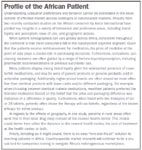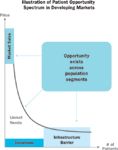New Rules for a New Africa
Pharmaceutical Executive
As growth in the BRICs and other emerging economies begins to stabilize, companies are finally turning their attention to Africa-a hidden trove of potential that is only as good as you make it.
Africa has long been seen as a caricature of calamity—an object lesson on what not to do in making public health a driver of balanced economic and social development. Ravaged by a potent mix of infectious and chronic non-communicable diseases and political conflicts, the region sat neglected by investors for decades, a destination to nowhere even for companies with a business commitment to better health. The greatest mistake was to consider Africa as the "carbon copy" continent: uniformly poor, culturally deprived, and entrepreneurially challenged despite its immense, varied topography and a rich, complex mosaic of ethnic and racial affiliations.

(Getty Images/David Malan)
But things change. Africa now deserves a second look, however, especially as growth prospects in the mature markets of Europe and the United States are fading due to aging populations and deepening fiscal constraints in key demand sectors like healthcare. Africa actually now presents a refreshing contrast to this politics of decline, with the world's youngest population and a new highly educated class of business leaders that has benefited from a regional transition to democracy—"regime change" in most countries is now taking place peacefully, through the ballot box.
Just a decade ago, Africa was an uncharted frontier for most of the global pharmaceutical majors. Companies familiar with the structured world of developed markets found themselves without the necessary tools to identify opportunities and build market share in the region. A key concern at the time for African governments was how best to leverage private sector support to find solutions to system-wide healthcare issues like access to medicines. In one of the first examples of public/private sector cooperation, the Abbott Fund and the government of Tanzania formed in 2001 a joint collaboration to strengthen basic health infrastructure. During this time, many hours were spent working closely with the Ministry of Health to highlight critical areas of needs in the midst of what was a chaotic time for many African nations. With more than 23 million people living with HIV/AIDS in Sub-Saharan Africa alone; skyrocketing case loads of tuberculosis, malaria, and other communicable ailments; and woeful under-capacity in essential primary care services, decision makers struggled to know where to start.
As the HIV/AIDS epidemic grew, so did pressure on the global pharma industry to invest in infrastructure and capacity building projects and to provide free-of-cost or lower-cost goods as a subsidy to patients and governments. This left many companies, whose business model focused on serving urban hospitals and the small slice of the population with the means to pay for medicines out-of-pocket, totally unprepared. With countless non-profit and national and multilateral aid organization playing the lead role in managing the health crisis, the pharmaceutical companies' hands-off stance led to them taking a reputational hit, with a spillover impact on the big Western markets where most of their profits were spun.
While clouded with controversy, some industry investments in Africa did play a role in controlling the disease burden, building infrastructure, and even contributed to policy development, in some cases. For example, as part of the Abbott Fund project, an HIV/AIDS wing was built at the Kilimanjaro Christian Medical College (KCMC) in Moshi, Tanzania. After completion in 2003, the beds were quickly filled with HIV/AIDS and tuberculosis patients requiring in-patient care, and over time, the availability of ARVs led to a significant decrease in HIV/AIDS-related hospitalizations in the district. Another example is a recently published impact analysis (BMC Public Health) of Boehringer Ingelheim's Viramune Donation Program, which from 2000-2013 provided free-of-cost the drug nevirapine in 34 Africa countries to mothers and their babies to prevent the transmission of HIV/AIDS. It found that availability of the drug at such a crucial time generated a positive cycle of community demand, which in turn encouraged the uptake of local comprehensive preventive mother to child HIV transmission services and fostered new partnerships with national and international organizations. The feedback helped create the political momentum to institutionalize these services through specific policy directives enforceable at the national level.

Africa arrives
Two decades later, Africa finds itself slowly emerging from the perils it once faced. The key driver is economic growth, which has raised living standards and consequently increased demand for health services. A 2011 report by the African Development Bank found that the ranks of Africa's middle class increased to 34 percent of the continent's population in 2010—nearly 313 million people, equivalent to the population of the United States. The continent's urban population is also projected to exceed that of China and India by 2050, according to UN figures. Along with greater political and fiscal stability and improvements in pro-business legislation, the UN forecasts that foreign direct investment (FDI) in Africa could more than double in 2014 compared to a decade ago.
Since 2000, healthcare spending has grown at a CAGR of 9.6 percent due to government, NGO, and private sector investments in system infrastructure, capacity building, treatment provisions, and specialized services. While infectious diseases like HIV/AIDS and tuberculosis still remain a significant problem, the changing economic profile of Africa has led to an increase in non-communicable diseases (NCDs), such as cardiovascular and respiratory disorders, cancer, and diabetes, and as a result, a growing demand for chronic care drugs. The World Health Organization (WHO) estimates that by 2020, the biggest increases in NCD deaths will occur in Africa.
This observation by a leading local health practitioner is telling. "In 2003, the beds in our new HIV/AIDS wing at KCMC were filled with HIV/AIDS patients whose disease was not under control. Since the introduction of affordable anti-retrovirals that decreased the disease burden, those beds are now filled with diabetes patients," Mark Swai, MD, former Hospital Director of KCMC, told Pharm Exec.
Increasing individual wealth, a somewhat stronger health system infrastructure, and rising demand for drugs treating chronic diseases are driving up sales of pharmaceuticals. By 2016, annual pharmaceutical spending in Africa is expected to reach $30 billion—surpassing the United Kingdom.
But how different is the Africa of today when it comes to healthcare provisions?
There is no doubt that there are promising changes ahead, yet one crucial component of a sound healthcare system lags: a weak infrastructure, especially in primary care, accentuated by a shortage of facilities and trained staff, limited disease awareness, and frequent changes in regulatory and distribution rules. As in most other areas of the African economy, creation of an efficient, boundary-less regional market in medicines remains elusive.
Take the doctor to patient ratio for example: according to the most recent World Bank figures available, Mozambique has less than one physician per 10,000 people, as does Gambia, Ghana, and Ethiopia. South Africa has less than one physician per 1,250. Compare this to physician population ratios of one to 300 and one to 425 for France and the United States, respectively. With such a low physician to patient ratio, prescriber-focused sales and marketing tactics are not practicable. Combine this with a still poorly understood heterogeneous market and a decision chain that is notably hard to navigate and you have to ask if a long-term integrated business strategy is possible within these current infrastructure limitations. It follows that the most important question of the moment for pharma investors is: what commitments and level of spending are necessary to overcome these limitations and leverage the region's full market potential?
"There are clear improvements since the early days of the HIV/AIDS epidemic. However, the needs keep changing. What was put in place to treat infectious diseases is not what is needed to keep diabetes patients out of the hospital today," said Swai. Swai's story illustrates how the evolving disease landscape in Africa has exceeded the capacity of health systems to adapt and respond to a new crisis in chronic care, resulting in unnecessary complications for patients and added operational and financial burden on African hospitals.
One fact for Big Pharma is clear: While the role of the pharmaceutical sector in Africa is undoubtedly changing, the need to ensure that private-sector initiatives support and drive infrastructure improvements remains essential. It is the single most important element in a long-term, sustainable market access strategy for Africa.
Learning from the past
Before addressing key market access considerations in Africa today, it is important to look at what we already know.
Much has been learned from the industry's efforts in Africa to date, and similarly, African governments have grown significantly more informed in their approach to working with the private sector. Gone are the days of "I'll take what I can get." In its place is a new generation of leaders who have overcome epidemics and political instability and now demand smart, actionable, long-term strategies that will address the growing burdens on national healthcare systems. The same goes for the general population. After two decades of external influence from private companies and donors alike, African patients have grown more sophisticated and have developed distinct behaviors and preferences when it comes to healthcare choices (see Profile of the African Patient sidebar).

Profile of the African Patient
The last 10 years have been tumultuous for the pharma industry as it struggled to establish a truly global presence beyond the mature markets of the United States, Europe, and Japan. While each region of the world has its own unique business context, barriers to entry led by low affordability and limited infrastructure are the overarching themes that join all developing or emerging markets. Pharmaceutical companies have built significant expertise on how to overcome these barriers in developing markets through their work in Asia, Latin America, and the Middle East. It is important that this knowledge is leveraged as market access strategies are developed for Africa.
Any blueprint for African growth should consider the following:
First and foremost, the ability to pay must take informal sources into consideration. Traditionally, income, expenditures, or wealth have been used as a primary indicator of financial status. However, informal and cash economies, predominant in African countries, make it difficult to accurately assess real ability to pay. An approach that looks at a range of indicators together should be considered.
There is a significant middle income bracket of the population that is not being reached by traditional access solutions. Health insurance in developing countries is neither widely available nor affordable for most people and the majority of patients pay for healthcare expenses out of pocket. Although the very wealthy can afford to pay for patented medications, and the very poor may be able to participate in donation programs organized by pharmaceutical companies, those in the middle of the economic scale face substantial hurdles to accessing needed drugs (see Patient Opportunity Spectrum in Developing Markets figure).

Building up the value of a product in the eye of the payer(s) is essential given the low affordability, limited to no reimbursement, purchasing decisions that are not always dictated by prescriptions, and the availability of generic alternatives. Value building comes in many forms, from setting the right price to utilizing marketing tactics that target informal channels of influence. Regardless of the method utilized, what is important is that your value proposition is locally relevant, applicable to patient preferences and mindful of the competitive landscape in the country.
There is significant competition for how a low monthly wage should be spent in resource-poor settings. Many patients are paid weekly or on an ad-hoc basis, so ability to purchase may vary from week to week. Patients must constantly prioritize purchases based on needs and available financial resources and this plays a significant role on healthcare expenditures.
With low doctor to patient ratios, prescriber-focused sales and marketing techniques have their limits. Deploying a sales force to target key physicians as your primary means of outreach will likely limit your market potential. Instead, coupling a well-trained local sales force with initiatives to educate informal channels of influence, such as community health workers, nurses, and pharmacists, may be more effective in reaching the full patient spectrum across affordability levels.
Strategies for success
How can we apply what we already know to successfully navigate the current African context and establish a fruitful presence in the continent? Consider the following:
Strengthen data to inform the opportunity. There is much we still don't know about the African market. Africa is extremely heterogeneous, and one-size-fits-all solutions are bound to fail. Country-specific market research will be a crucial tool for understanding the path to market, the path to patient, and related barriers.
Stimulate demand. While providing treatment via donations or cost sharing schemes addresses one part of the problem, a sustainable market access strategy, particularly for an innovative drug, should also include disease management, capacity and infrastructure building, and stakeholder engagement components to drive public demand from the ground up. Building this demand will ultimately affect policy decisions that can positively impact sales in the long-run.
Understand the importance of informal channels and the power shift from prescribers. Decisions in Africa—be it prescribing, purchasing, or policy decisions—are often guided by a range of parties, many outside the formal spectrum of influencers. Key Opinion Leaders (KOLs) are no longer just leading physicians in the field. They include the range of people that make up a patient's "treatment journey"—community leaders, community health workers, pharmacists, nurses, religious groups, aid workers, and NGO representatives. Identifying these influencers is just a first step. The real game changer is a smart engagement strategy that puts stakeholders in the center of the solution.

Look more broadly at the population. By 2015, 221 million additional basic needs consumers (defined as those between the $1,000-$5,000 income bracket) will enter the market in Africa. This represents 55 percent of Africa's population, compared with 39 percent who fell into the basic needs category in 2005. While this income bracket is still low compared to other developing regions, it represents a new market base that will likely not be reached with traditional access approaches. To reach the full patient base, consider how market potential can be maximized by segmenting across the affordability spectrum. For example, by putting in place cost sharing strategies for medium-priced drugs that allow patients to pay only what they can afford and bringing in other parties to cover the remainder, higher income patients are in essence able to "subsidize" lower income patients—thereby growing the patient pool.
Consider the role of willingness to pay. In low affordability environments, willingness to pay must be considered as strongly as ability to pay. Unless the condition is debilitating enough to limit future income generation, preventing or even treating non-essential health issues is not always a priority for a patient that falls in or below the "basic needs" bracket. This is particularly true for chronic diseases that are often progressive in nature. For these reasons, educating patients so they understand the need for prevention or treatment, ensuring that your product value is communicated clearly by influencers, and pricing your product appropriately are key.
Select and monitor distribution channels carefully. Availability in pharmacies can often dictate product purchase so a carefully maintained supply chain and distribution system should be in place. In addition, to avoid price inflation, "cutting out the middle man" is an important reality in the African market. Intermediaries and markups can sometimes increase net selling price by four to six times.
Remember the importance of ongoing corporate social responsibility (CSR) efforts. While many companies' presence in Africa to date have been tied to CSR efforts alone, the changing landscape and growing commercial opportunities should not mean the end of these initiatives. Instead, socially responsible market access practices that are sustainable should be seen as complements to CSR practices.
Leverage partnerships with local governments and organizations. Working with governments to support policies and integrated health delivery systems that work in unison with, but not parallel to, existing health systems, is a primary way to ensure that private sector investments in infrastructure garner the proper ROI for commercial sustainability. Instead of detailing products via a local sales force for example, take a step back and consider the need for clinical treatment guidelines and work closely with local governments to develop them. Furthermore, organizations on-the-ground that have local knowledge and relationships can also serve as tremendous assets to establish a footprint and help navigate barriers to market.
Invest in smart infrastructure and capacity initiatives. Focus on skills transfer, and ensure commitment to this at the company headquarters level early in the market access strategy development process.
In time, the results of these initiatives will become the foundation of commercial success in Africa. While it is a longer-term solution, pharmaceutical companies willing to take the effort and make the investment will no doubt reap the rewards. In essence, when it comes to Africa, the market is what you make it.

Joseph Saba, MD, is Co-Founder and CEO of Axios International, a healthcare consulting company specialized in the delivery of sustainable solutions to drive access to care in emerging markets. He can be reached at joseph.saba@axiosint.com.

The Misinformation Maze: Navigating Public Health in the Digital Age
March 11th 2025Jennifer Butler, chief commercial officer of Pleio, discusses misinformation's threat to public health, where patients are turning for trustworthy health information, the industry's pivot to peer-to-patient strategies to educate patients, and more.
Navigating Distrust: Pharma in the Age of Social Media
February 18th 2025Ian Baer, Founder and CEO of Sooth, discusses how the growing distrust in social media will impact industry marketing strategies and the relationships between pharmaceutical companies and the patients they aim to serve. He also explains dark social, how to combat misinformation, closing the trust gap, and more.
Applying Porter’s Five Forces to Portfolio Management in Pharmaceutical R&D: A Strategic Roadmap
March 17th 2025The increasing costs and complexity of R&D in the pharmaceutical industry have necessitated the adoption of strategic portfolio management to optimize resource allocation and enhance competitive advantage.